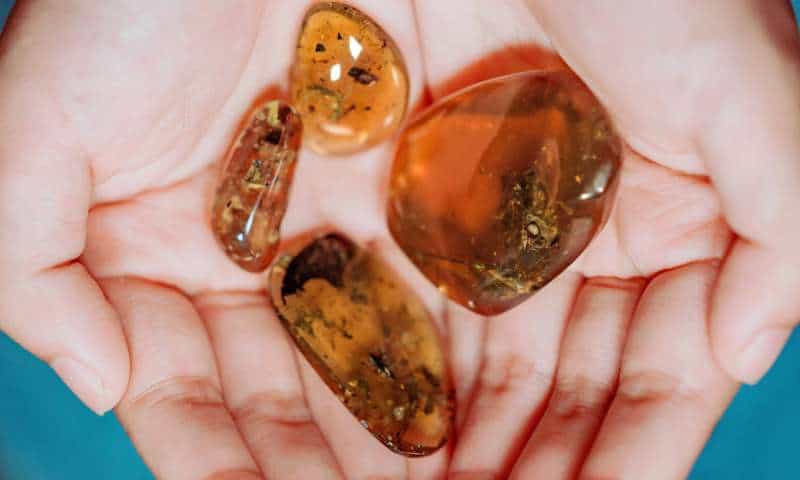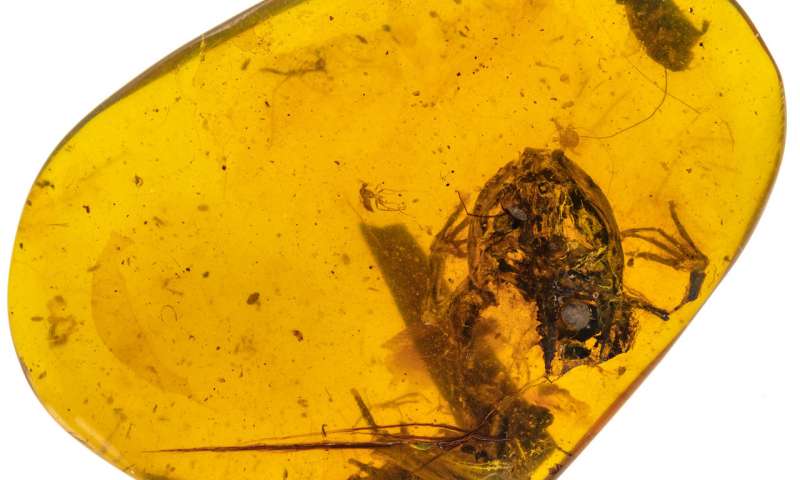
These 99-million-year-old amber fossils provide the earliest direct evidence of frogs living in wet, tropical forests. Credit: Lida Xing/China University of Geosciences.
Millions of years ago, a juvenile frog was preparing to turn an unsuspecting beetle into a nice, juicy meal. Unfortunately for them, both frog and bug got trapped in sticky resin. Lucky for us, the sap turned to amber, beautifully preserving the fossil frog’s small bones and hints of its tropical environment. This is, in fact, the oldest frog we’ve ever found in a tropical environment — and the oldest frog trapped in amber, for that matter.
Nature’s time capsule
Although frogs have been around for at least 200 million years, being so small and mushy, scientists rarely find early fossils of them. The fossil record is skewed towards species from arid and seasonal environments, which are more robust. This is why the new 99-million-year-old amber fossils are so important to scientists — they provide a very rare insight into the lives of ancient frogs that used to live in wet environments. More than a third of the nearly 7,000 species of frogs live in these wet forests.
“Ask any kid what lives in a rainforest, and frogs are on the list,” said David Blackburn, study co-author and the associate curator of herpetology at the Florida Museum of Natural History, in a statement. “But surprisingly, we have almost nothing from the fossil record to say that’s a longstanding association.”
“These frogs were part of a tropical ecosystem that, in some ways, might not have been that different to what we find today—minus the dinosaurs,” he added.
The amber fossils were recovered from amber deposits in northern Myanmar, Southeast Asia, and have been dated to about 99 million years old. Besides ancient frog remains, the amber fossils also trapped plants, spiders, insects, and marine mollusks.
Amber is like nature’s time capsule. When the tree has a wound (like a broken branch) or if it is attacked by insects or fungi, it exudes the thick resin that plugs up the injury and prevents further damage. In certain conditions of pressure and temperature, typically after becoming covered in sediments, the resin can turn into a solid orange gem whose contents become preserved for millions of years.
For instance, the amber beautifully preserved the tiny frog, which is less than an inch long, visibly showing its skull, forelimbs, and part of its backbone and hind limb. Two other amber fossils contain two forelimbs and an imprint of a frog.
Frogs in amber are quite rare, with previous examples found in the Dominican Republic and Mexico and dating back to only about 40 million and 25 million years, respectively.

One of the most well preserved amber fossils in the lot. It contains the skull, forelimbs, part of a backbone and a partial hind limb of an ancient juvenile frog. Credit: Lida Xing/China University of Geosciences.
The researchers performed a comparative analysis of the ancient frogs, which they dubbed Electrorana limoae, with similar species living today. They uncovered more common ground than differences, suggesting that frogs haven’t really changed that much across the eons. For instance, the ribs and a bone in the cartilaginous plate that supports the tongue suggest Electrorana l. closely resembled some of the species alive today, such as fire-bellied toads and midwife toads. But these are Eurasian species that live in temperate, not tropical, ecosystems.
What’s more puzzling is that the juvenile is missing or hadn’t yet had the chance to develop certain features that herpetologists usually look for in order to discern frog species. Features such as wrist bones, the pelvis, hip bones, the inner ear, the top of the backbone.
For now, Electrorana raises more questions than it answers but Blackburn and colleagues hope to find more specimens trapped in amber.
“We don’t have a lot of single-species frog communities in forests. It seems extremely unlikely that there’s only one. There could be a lot more fossils coming,” the authors wrote in the journal Scientific Reports.
Scientific reference: Lida Xing et al, The earliest direct evidence of frogs in wet tropical forests from Cretaceous Burmese amber, Scientific Reports (2018). DOI: 10.1038/s41598-018-26848-w.









